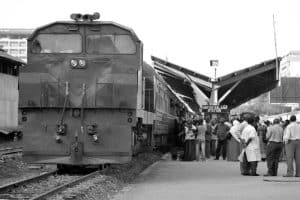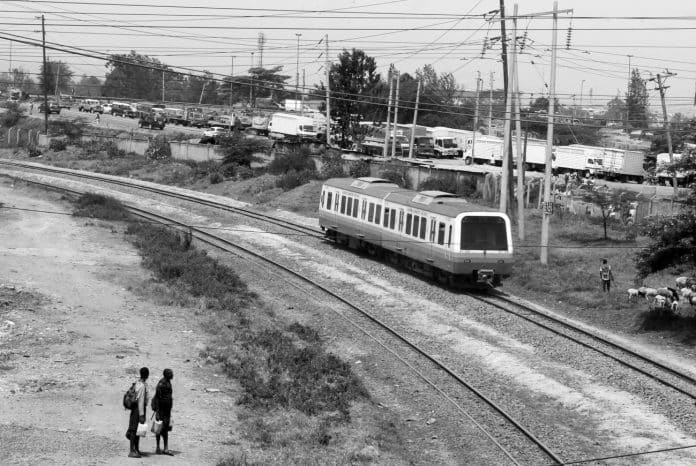History and Significance of the Tabora-Mwanza Railway Line
The Tabora-Mwanza railway line, also known as the Central Line, has been a crucial part of Tanzania’s transportation infrastructure since its inception in the early 20th century. Constructed during the German colonial era, this rail network was designed to connect the coastal regions with the country’s inland areas, enabling the efficient transport of agricultural products, minerals, and other resources.
Over the years, the Tabora-Mwanza railway line has remained a vital artery, connecting the bustling port city of Mwanza on the shores of Lake Victoria with the heart of the country. This line has played a pivotal role in facilitating trade, commerce, and economic development, serving as a vital link between the coastal and inland regions of Tanzania.
Economic Impact of the Railway on Tabora
The presence of the Tabora-Mwanza railway line has had a significant impact on the local economy of Tabora. As a major transportation hub, the city has become a hub for various commercial activities, including the storage, processing, and distribution of agricultural products, minerals, and other goods.
The railway has also attracted a diverse range of businesses to Tabora, from warehousing and logistics companies to manufacturing and processing facilities. This influx of economic activity has created numerous job opportunities for the local population, contributing to the overall economic growth and development of the region.
Moreover, the railway has made it easier for Tabora’s residents to access markets, services, and resources across Tanzania, improving their standard of living and quality of life.
Development and Expansion Plans for the Tabora-Mwanza Railway Line

In recent years, the Tanzanian government has recognized the strategic importance of the Tabora-Mwanza railway line and has invested in its ongoing development and expansion. These efforts aim to modernize the infrastructure, increase efficiency, and enhance the overall capacity of the railway network.
Some of the key development and expansion plans for the Tabora-Mwanza railway line include:
- Track Rehabilitation and Upgrades:
- Ongoing maintenance and repair of the existing railway tracks to ensure safe and reliable operations.
- Replacement of aging infrastructure, such as bridges and signaling systems, to improve overall efficiency.
- Capacity Expansion:
- Constructing additional tracks and sidings to accommodate increased traffic and reduce bottlenecks.
- Upgrading locomotives and rolling stock to enhance the carrying capacity and speed of the trains.
- Intermodal Connectivity:
- Improving the integration of the railway with other modes of transportation, such as roads and ports, to create a seamless multimodal transportation network.
- Developing modern logistics hubs and intermodal terminals in Tabora to facilitate the efficient transfer of goods between different modes of transport.
These development and expansion plans are expected to further strengthen Tabora’s position as a crucial railway hub, enhancing the overall efficiency and competitiveness of Tanzania’s transportation infrastructure.
Transportation and Logistics Benefits of the Railway
The Tabora-Mwanza railway line offers numerous transportation and logistics benefits, making it an essential component of Tanzania’s supply chain and distribution network.
- Cost-effective Freight Transport:
- The railway provides a cost-effective mode of transporting large volumes of goods over long distances, particularly for commodities such as agricultural products, minerals, and construction materials.
- This cost-effectiveness helps to reduce the overall logistics expenses for businesses, improving their competitiveness in domestic and international markets.
- Improved Connectivity:
- The railway line connects Tabora to various other major cities and regions within Tanzania, facilitating the seamless movement of goods and people across the country.
- This improved connectivity enhances access to markets, resources, and services, supporting the growth and development of local and regional economies.
- Reduced Environmental Impact:
- Compared to road transportation, the railway offers a more environmentally-friendly mode of freight transport, with lower carbon emissions and reduced fuel consumption.
- This aligns with the growing global emphasis on sustainable logistics and transportation practices.
- Increased Cargo Capacity:
- The railway’s ability to transport large volumes of goods in a single trip helps to reduce the number of vehicles on the roads, easing congestion and improving overall transportation efficiency.
- This increased cargo capacity is particularly beneficial for the movement of bulk commodities and heavy goods.
By leveraging these transportation and logistics benefits, businesses and individuals in Tabora and the surrounding regions can optimize their supply chain operations, enhance their competitiveness, and contribute to the overall economic development of Tanzania.
Tabora’s Role in Connecting Tanzania’s Inland Routes
Strategically located at the intersection of several major inland routes, Tabora has become a crucial hub for the movement of goods, people, and resources throughout Tanzania. The city’s railway network, combined with its road infrastructure, has enabled it to serve as a vital link between the coastal regions and the country’s inland areas.
- Connecting the North and South:
- The Tabora-Mwanza railway line serves as a crucial north-south corridor, connecting the bustling port city of Mwanza on Lake Victoria with the southern regions of the country.
- This north-south connectivity facilitates the efficient transport of agricultural products, minerals, and other resources between the coastal and inland areas.
- Integrating the East and West:
- Tabora’s road network, including the Tanzania-Zambia Highway (TANZAM), connects the eastern and western regions of the country, enabling the movement of goods and people across the inland routes.
- This east-west connectivity is particularly important for the transport of goods between the coastal ports and the landlocked countries in the region, such as Zambia and the Democratic Republic of the Congo.
- Multimodal Logistics Hub:
- The combination of the Tabora-Mwanza railway line and the city’s road network has transformed Tabora into a multimodal logistics hub, where different modes of transportation converge to facilitate the efficient movement of goods.
- This multimodal connectivity allows for the seamless transfer of cargo between different modes of transport, optimizing the overall supply chain and distribution processes.
By serving as a critical junction for Tanzania’s inland routes, Tabora has become an essential component of the country’s transportation infrastructure, supporting the economic development and integration of the various regions within the country.
Challenges Faced by the Tabora-Mwanza Railway Line

While the Tabora-Mwanza railway line has been a vital asset for Tanzania’s transportation network, it has also faced several challenges over the years. Understanding and addressing these challenges is crucial for ensuring the continued efficiency and reliability of this important transportation corridor.
- Aging Infrastructure:
- Much of the railway’s infrastructure, including tracks, bridges, and signaling systems, has been in use for decades and is in need of ongoing maintenance and upgrades.
- Delayed or inadequate investment in infrastructure improvements can lead to operational disruptions, reduced efficiency, and safety concerns.
- Capacity Constraints:
- The growing demand for freight and passenger transport has put a strain on the railway’s existing capacity, leading to bottlenecks and delays.
- Expanding the network’s capacity through the construction of additional tracks and the modernization of rolling stock is essential to meet the increasing transportation needs.
- Operational Efficiency:
- Factors such as outdated technology, inefficient scheduling, and maintenance challenges can impact the overall operational efficiency of the railway line.
- Implementing modern management practices, investing in digital technologies, and optimizing maintenance procedures can help to improve the railway’s performance.
- Regulatory and Governance Challenges:
- Navigating the complex regulatory environment and ensuring effective governance of the railway system can be a significant challenge.
- Streamlining policies, improving coordination between stakeholders, and enhancing transparency in decision-making can help to address these challenges.
- Funding and Investment Constraints:
- Securing the necessary funding and investment for the ongoing development and maintenance of the Tabora-Mwanza railway line can be a persistent challenge.
- Exploring innovative financing mechanisms, public-private partnerships, and international cooperation can help to mobilize the resources required for infrastructure upgrades and capacity expansion.
Addressing these challenges will be crucial for ensuring the long-term sustainability and competitiveness of the Tabora-Mwanza railway line, ultimately strengthening Tanzania’s overall transportation network and facilitating the country’s economic growth and development.
Successful Stories and Case Studies of Businesses Benefiting from the Railway
The Tabora-Mwanza railway line has played a pivotal role in enabling the success of various businesses across Tanzania. Here are a few case studies that illustrate the positive impact of this vital transportation corridor:
- Agribusiness Expansion:
- ABC Farm, a leading agricultural producer in the Tabora region, has been able to significantly expand its operations and reach new markets thanks to the efficient transportation provided by the railway.
- The company has been able to transport its crops, such as corn and rice, to processing facilities and distribution centers across the country, boosting its productivity and profitability.
- Mineral Extraction and Processing:
- XYZ Mining, a prominent mining company, has leveraged the Tabora-Mwanza railway line to transport its mineral resources from the inland mines to the coastal ports for export.
- The railway’s cost-effective and reliable transportation services have enabled the company to optimize its supply chain, reducing logistics expenses and improving its overall competitiveness in the global market.
- Logistics and Distribution:
- Logistix Solutions, a leading logistics and distribution company, has established a major hub in Tabora to take advantage of the city’s strategic location and the efficiency of the railway network.
- By utilizing the Tabora-Mwanza railway line, the company has been able to streamline its operations, reduce transit times, and provide faster and more reliable delivery services to its clients across Tanzania.
- Manufacturing and Processing:
- Tanzanian Textile Company, a textile manufacturer, has set up a production facility in Tabora, leveraging the railway’s transportation capabilities to source raw materials and distribute its finished products.
- The company’s access to the railway network has allowed it to reduce its transportation costs, improve its supply chain efficiency, and expand its market reach within the country and beyond.
These success stories illustrate the significant impact that the Tabora-Mwanza railway line has had on businesses across various industries, enabling them to enhance their competitiveness, expand their operations, and contribute to the overall economic development of Tanzania.
Future Prospects and Opportunities for Tabora as a Railway Hub
As Tanzania continues to invest in the development and expansion of its transportation infrastructure, Tabora’s role as a strategic railway hub is poised to grow even more prominent in the years to come. The city’s central location, coupled with the ongoing improvements to the Tabora-Mwanza railway line, presents numerous opportunities for businesses and individuals alike.
- Increased Cargo Capacity and Efficiency:
- The planned capacity expansions, including the construction of additional tracks and the modernization of rolling stock, will enable the Tabora-Mwanza railway line to handle larger volumes of freight and passengers more efficiently.
- This enhanced capacity will benefit a wide range of industries, from agriculture and mining to manufacturing and logistics, by providing more reliable and cost-effective transportation services.
- Multimodal Logistics Hub Development:
- Tabora’s position as a multimodal transportation hub is expected to be further strengthened, with the development of modern logistics centers and intermodal terminals.
- These facilities will facilitate the seamless transfer of goods between different modes of transport, improving overall supply chain efficiency and reducing logistics costs.
- Attracting New Investments and Businesses:
- The improved transportation infrastructure and the enhanced connectivity provided by the Tabora-Mwanza railway line are likely to attract new investments and businesses to the region.
- This influx of economic activity will create job opportunities, stimulate local economic growth, and contribute to the overall development of Tabora and the surrounding areas.
- Tourism and Regional Integration:
- The railway’s improved passenger transport capabilities may also open up new opportunities for tourism, allowing visitors to explore the diverse landscapes and cultural attractions within Tanzania.
- Furthermore, the enhanced regional connectivity facilitated by the Tabora-Mwanza railway line can contribute to the economic integration of the East African Community (EAC) and the Southern African Development Community (SADC) regions.
As Tabora continues to cement its role as a vital railway hub, the city and the surrounding regions are poised to reap the benefits of increased economic activity, job creation, and improved access to markets and resources. By leveraging these opportunities, Tabora can solidify its position as a key driver of Tanzania’s transportation and economic development.
For more articles related to Railway and train travel Tanzania, click here!

































